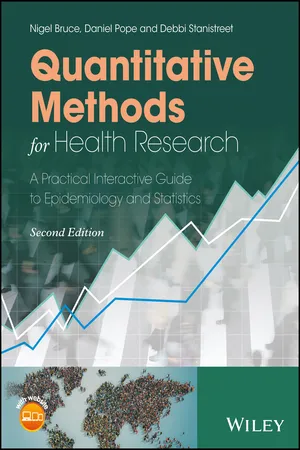
Quantitative Methods for Health Research
A Practical Interactive Guide to Epidemiology and Statistics
- English
- ePUB (mobile friendly)
- Available on iOS & Android
Quantitative Methods for Health Research
A Practical Interactive Guide to Epidemiology and Statistics
About this book
A practical introduction to epidemiology, biostatistics, and research methodology for the whole health care community
This comprehensive text, which has been extensively revised with new material and additional topics, utilizes a practical slant to introduce health professionals and students to epidemiology, biostatistics, and research methodology. It draws examples from a wide range of topics, covering all of the main contemporary health research methods, including survival analysis, Cox regression, and systematic reviews and meta-analysis—the explanation of which go beyond introductory concepts. This second edition of Quantitative Methods for Health Research: A Practical Interactive Guide to Epidemiology and Statistics also helps develop critical skills that will prepare students to move on to more advanced and specialized methods.
A clear distinction is made between knowledge and concepts that all students should ensure they understand, and those that can be pursued further by those who wish to do so. Self-assessment exercises throughout the text help students explore and reflect on their understanding. A program of practical exercises in SPSS (using a prepared data set) helps to consolidate the theory and develop skills and confidence in data handling, analysis, and interpretation. Highlights of the book include:
- Combining epidemiology and bio-statistics to demonstrate the relevance and strength of statistical methods
- Emphasis on the interpretation of statistics using examples from a variety of public health and health care situations to stress relevance and application
- Use of concepts related to examples of published research to show the application of methods and balance between ideals and the realities of research in practice
- Integration of practical data analysis exercises to develop skills and confidence
- Supplementation by a student companion website which provides guidance on data handling in SPSS and study data sets as referred to in the text
Quantitative Methods for Health Research, Second Edition is a practical learning resource for students, practitioners and researchers in public health, health care and related disciplines, providing both a course book and a useful introductory reference.
Frequently asked questions
- Essential is ideal for learners and professionals who enjoy exploring a wide range of subjects. Access the Essential Library with 800,000+ trusted titles and best-sellers across business, personal growth, and the humanities. Includes unlimited reading time and Standard Read Aloud voice.
- Complete: Perfect for advanced learners and researchers needing full, unrestricted access. Unlock 1.4M+ books across hundreds of subjects, including academic and specialized titles. The Complete Plan also includes advanced features like Premium Read Aloud and Research Assistant.
Please note we cannot support devices running on iOS 13 and Android 7 or earlier. Learn more about using the app.
Information
1
Philosophy of Science and Introduction to Epidemiology
Introduction and Learning Objectives
Learning Objectives
- Briefly describe the key differences between the main approaches to research that are used in the health field.
- Describe what is meant by epidemiology, and list the main uses to which epidemiological methods and thought can be put.
- Describe what is meant by statistics, and list the main uses to which statistical methods and thought can be put.
- Define and calculate rates, prevalence, and incidence, and give examples of their use.
- Define primary, secondary, and tertiary prevention and give examples of each.
1.1 Approaches to Scientific Research
1.1.1 History and Nature of Scientific Research
- What do you understand by the terms science and scientific research, especially in relation to health?
- How has your understanding of research developed?
- What type of research philosophy best fits your view of the world and the health issues you are most interested in?
Scientific Reasoning and Epidemiology
Table of contents
- Cover
- Title page
- Copyright
- Preface
- About the Companion Website
- 1 Philosophy of Science and Introduction to Epidemiology
- 2 Routine Data Sources and Descriptive Epidemiology
- 3 Standardisation
- 4 Surveys
- 5 Cohort Studies
- 6 Case–Control Studies
- 7 Intervention Studies
- 8 Life Tables, Survival Analysis, and Cox Regression
- 9 Systematic Reviews and Meta-Analysis
- 10 Prevention Strategies and Evaluation of Screening
- 11 Probability Distributions, Hypothesis Testing, and Bayesian Methods
- Bibliography
- Index
- EULA